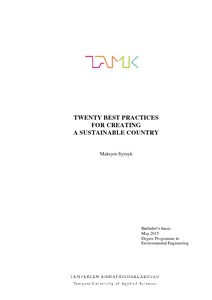Twenty best practices for creating a sustainable country
Sytnyk, Maksym (2015)
Julkaisun pysyvä osoite on
https://urn.fi/URN:NBN:fi:amk-201505209114
https://urn.fi/URN:NBN:fi:amk-201505209114
Tiivistelmä
Sustainable development is essential in the modern world. One of the ways to achieve it is to move towards a circular economy. The 20 best practices which are presented in this thesis aim to work as tools that can be used to promote sustainability in every country.
The practices are all different in nature, covering areas such as waste management, transportation, landscape planning, environmental legislation and individual initiatives. Some of them represent the concept of the circular economy in its ideal form, while others are transitional measures, which lead towards a circular economy.
The purpose of the work is to show examples of what can be done nationwide to make a country environmentally, socially and economically sustainable. The methods presented in the research are based on case studies, SWOT analysis, and a communication plan for putting the practices into action.
The thesis includes discussion of general patterns and top issues from the case studies and the SWOT analyses, as well as the factors that are crucial for implementing the best practices. The findings are used to project the implementation of the best practices in Ukraine.
The results indicate that successful introduction of good practices depends on several crucial factors, such as the governmental mechanisms in the country concerned, its economy, the financial wealth and level of education of its citizens, and the effectiveness of the communication plan used for implementing each practice.
Generally, this work has an educative message. It presents different approaches in environmental management and technologies commonly used in developed countries, and this information can be useful for all those interested in understanding the nature of many effective practices for sustainable development.
The practices are all different in nature, covering areas such as waste management, transportation, landscape planning, environmental legislation and individual initiatives. Some of them represent the concept of the circular economy in its ideal form, while others are transitional measures, which lead towards a circular economy.
The purpose of the work is to show examples of what can be done nationwide to make a country environmentally, socially and economically sustainable. The methods presented in the research are based on case studies, SWOT analysis, and a communication plan for putting the practices into action.
The thesis includes discussion of general patterns and top issues from the case studies and the SWOT analyses, as well as the factors that are crucial for implementing the best practices. The findings are used to project the implementation of the best practices in Ukraine.
The results indicate that successful introduction of good practices depends on several crucial factors, such as the governmental mechanisms in the country concerned, its economy, the financial wealth and level of education of its citizens, and the effectiveness of the communication plan used for implementing each practice.
Generally, this work has an educative message. It presents different approaches in environmental management and technologies commonly used in developed countries, and this information can be useful for all those interested in understanding the nature of many effective practices for sustainable development.

